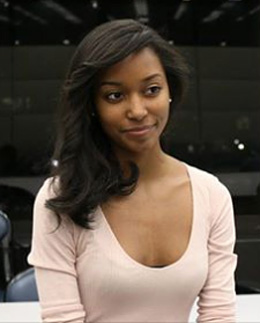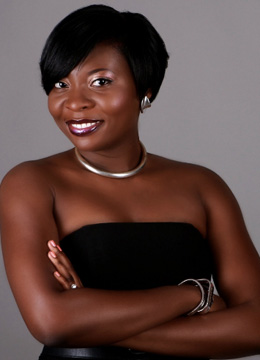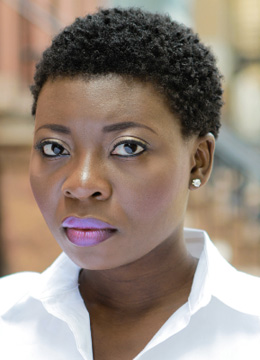The Natural Hair Movement
By Jasmine Medina

Sara Rosa
It’s five o’clock in the morning and Sara Rosa is getting ready to tackle the most difficult part of her morning routine: her hair. She passes a scorching flat iron over her thick coarse hair several times, making sure not to miss a single ringlet. “It takes about two hours everyday for me to straighten it. It’s not my favorite part of the day, but I have to do it,” said the 20-year-old Lehman College English major. “If I had the choice, I would wear my hair natural. I love that the natural hair movement stands for women embracing how they naturally are, but I don’t think that the professional world is embracing it yet.”
The natural hair movement is nothing new. However, its recent economic impact leads many to believe that the movement is more than just a fad. According to reports from the market research company Mintel, relaxer sales dropped 34 percent from 2009 to 2014. The report also found that the sales for natural hair care products increased 12 percent from 2009 to 2014. Relaxer sales are expected to fall 45 percent by 2019.
Although a growing number of minority women embrace their natural hair textures, for Abi Ishola, the professional world is not as accepting.

Abi Ishola before going natural
“When it boils down to it, most black women working in the media wear their hair straight,” the 35-year-old multimedia journalist said. “The few women that do wear their hair natural often have to explain themselves for doing so.”
In the Hispanic and African American communities negative attitudes towards textured hair trace all the way back to the 15th century during the European conquests of the Caribbean and the Americas. Members of the indigenous and slave populations were often pressured to marry someone who was whiter than them in order to purify future descendants. As a result, European features such as light skin and long straight hair were valued more than dark skin and coarse tightly curled hair.
Before the 1970s, minority women sought out any possible way to loosen their curl patterns. Businesses, such as the Madame C.J. Walker Company marketed products to ethnic women that helped assist the straightening process. Products such as the hot comb and relaxers gave minority women an easier way to duplicate their straight hairstyles everyday.
For 17-year-old aspiring journalist Imani Harris, the pressure to alter her hair texture was always there. “I wanted to straighten my hair for as long as I can remember,” said the writer for Affinity, an online magazine. “I have vivid memories of me crying as a child because my mom would not let me do anything to my hair. For me, straight hair meant pretty hair.”

Abi Ishola natural hair
The natural hair movement gained momentum during the 1970s with the rise of the Black Power Movement. Black Panther figures such as Angela Davis and Elaine Brown, wore their unaltered tresses in order to encourage other women to embrace their lineage and appreciate their hair. This led to a variety of natural styles such as the afro, jheri curls, box braids, and dreadlocks. However, for some women, the American definition of beauty stayed the same.
The decision for Ishola to go natural was not easy for her. “Back in 2011 my hair started to fall out after all the years of relaxing and straightening it,” she said. “The problem was that I started my career as an on-air reporter for a small TV station in New York City. I was scared of how I would look on camera with natural hair, and I wasn’t sure if natural hair would allow me to advance my career.”
Ishola shaved her head and wore a wig on air to protect her natural hair. But as time went on, her desires to be natural made her rethink her career as a broadcast reporter.
“I just got sick of having to cover my hair all the time. It felt like I was hiding an important part of who I am,” Ishola said. “Deep down, I knew that I was different from other TV reporters. My real passion was writing about entertainment, fashion, and beauty. I realized that there would always be a place for me no matter how I wore my hair.” Currently, Ishola still works as a multimedia journalist.
It was not until 2016 that Harris became inspired to go natural. One evening she saw a documentary on TV about a reporter named Rochelle Ritchie and the reporter’s decision to go natural. Seeing a woman of color with natural hair helped Harris in learning to embrace her own hair.

Imani Harris
Even though Harris does not regret going natural, part of her worries about how she will be able to find work in the future. “As an aspiring journalist, when I look on television and in media, I don’t see myself represented well. It’s hard enough to find a black woman as a TV reporter, much less a black woman with natural hair,” Harris said. “I don’t want my hair to hold me back from my passion, but I don’t want to have to alter myself to do what I love.”
Although Rosa is doubtful about pursuing a career in the media, she is hopeful that all facets of society will learn to accept natural hair.
“Straightening my hair may always be the most convenient thing for me to do when it comes to managing my hair,” she said. “ But I hope that one day I can go natural without worrying about looking unprofessional. I hope that one day I can be a part of the movement that allows people to open themselves up more to the idea that curly hair can be beautiful.”
